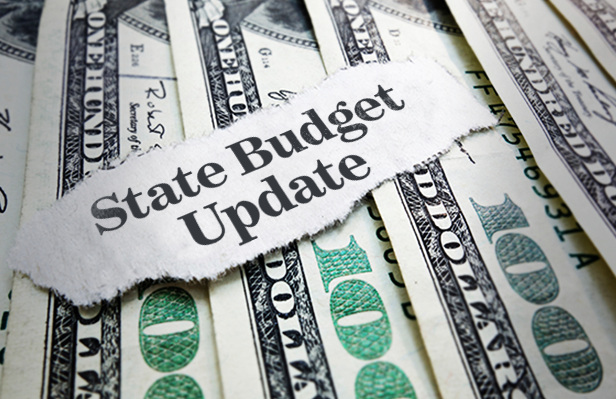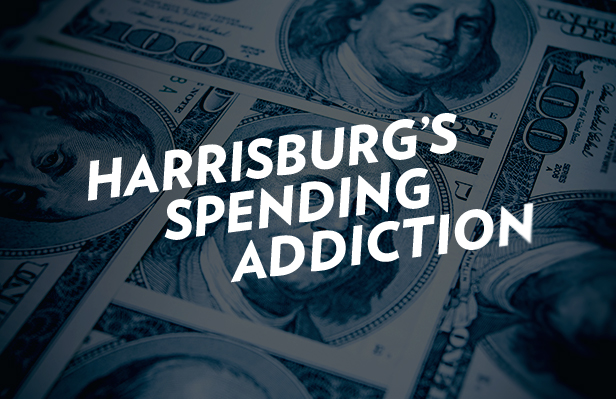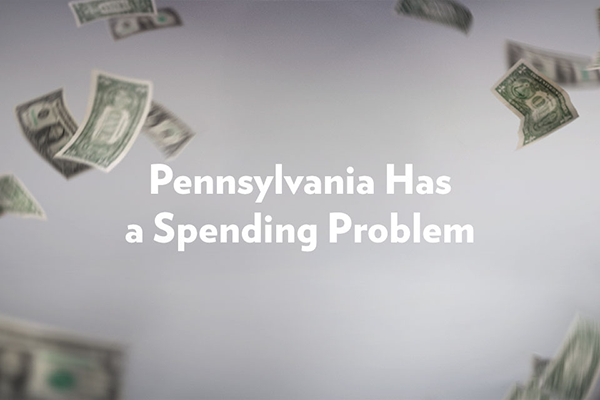On February 5, Governor Wolf will lay out his proposal for the 2019-20 state budget. Here are some key facts on spending trends, last year’s enacted budget, and challenges going forward.
The General Fund represents less than half the total operating budget.
Pennsylvania’s total operating budget, which includes federal funds and hundreds of additional state funds, exceeds $84 billion.
- Since 1970, Pennsylvania’s total operating budget increased by more than $16,000 per family of four (adjusted for inflation).
Graph: Pennsylvania Total Operating Budget (1970-2019)
Most spending growth is in the “shadow budget.”
While the General Fund budget commands much of the attention, most of the spending growth has been in other areas, called the “shadow budget.” Often items are moved outside the General Fund to mask spending growth or earmark funds for special projects.
Here is how the operating budget breaks down:
- General Fund: $32.7 billion (a $717 million increase in 2018-19).
- Federal Funds: estimated $29.6 billion (a $396 million increase).
- Special State Funds: estimated $4.9 billion (a $235 million increase).
- Other State Funds: estimated $17.2 billion (a $1.6 billion increase, or a massive 10.4 percent jump). This is the fastest growing part of state spending since 2000, caused in part by shifting funds out of the General Fund.
Graph: Total State Budget Growth (2000-2018)
Spending continues to exceed the Taxpayer Protection Act limit.
Last year, Gov. Wolf proposed a $33 billion General Fund budget, or $991 million in new spending. The legislature enacted a $32.7 billion budget, representing approximately $718 million in new spending—an increase of 2.2 percent.
- In the last four years, the General Fund budget has grown by $3.6 billion, or 12.2 percent, which significantly exceeds the rate of inflation.
- Except for 2018-19, these totals include “supplemental appropriations”—additional expenses or cost overruns above the budget passed by the legislature. Cost overruns for 2018-19 may add upwards of $200 million in additional spending.
- Increasing spending faster than inflation and population growth will create future budget deficits and require tax increases.
Graph: General Fund State Spending Increases
- The Taxpayer Protection Act (TPA) would limit this growth by capping General Fund spending increases to the rate of inflation plus population growth, subject to a supermajority vote to exceed this limit.
- The TPA, a version of which passed the House in 2017, would limit spending growth to 2.12 percent in 2019-20 (or a $33.41 billion General Fund budget).
Balancing the 2019-20 budget will be a challenge.
In November, the Independent Fiscal Office (IFO) projected a $1.7 billion deficit going into 2019-20; this despite robust revenue growth. While some of this deficit is the result of assuming discretionary spending increases, it is also the result of past decisions to push costs into next year.
- For fiscal year 2018-19, more than $800 million in Department of Human Services expenses were paid using one-time revenue sources that will not be available next year.
- New debt payments—including for PlanCon bonds (school construction), Tobacco Settlement bonds (funds borrowed to balance the 2016-17 budget), and payments for the Farm Show Lease—all begin next year.
- New program expenses for General Assistance, Medicaid Expansion, and shifting state police funding to the General Fund, will present additional challenges.
State and local government debt exceeds $10,000 per Pennsylvania resident.
Pennsylvania taxpayers continue to see their overall debt burden increase, primarily through state agencies—including the Pennsylvania Turnpike Commission and Commonwealth Financing Authority—and local governments.
- Pennsylvanians owe more than $128 billion in state and local government debt. This equals $10,015 for every man, woman, and child in the state.
- The totals below include debt in the form of government bonds but exclude unfunded pension liability and other post-employment benefits (e.g., retiree health care) for current and retired public sector employees.
Chart: PA State & Local Government Debt
Gov. Wolf is likely to propose new tax hikes.
Since taking office, Gov. Wolf has introduced or supported 11 different tax hike proposals.
- Pennsylvania has passed tax increases five times in the last 10 years, including a significant tax hike in 2016, and a minor tax hike in 2017.
- Gov. Wolf campaigned for reelection indicating no plans to raise taxes but has continued to call for a natural gas severance tax.
- This punitive tax would raise utility bills, reduce royalty payments, and eliminate jobs. Pennsylvania is the only state that taxes gas drillers with an “impact fee” in addition to all other business taxes. If we truly want to “[join] every other gas-producing state” as Gov. Wolf advocates, we would eliminate our state income tax and corporate tax.
- As a result of our high tax burden, Pennsylvania is losing jobs and residents. Last year, the commonwealth lost a net 20,463 residents to other states—a loss of two people every hour.
- In contrast, federal tax reform is boosting the state’s economy, and state tax revenue.
- In additional to lowering taxes on almost every family, corporate tax reform has led to more jobs and higher wages, and a reduction in utility bills. The Tax Cuts and Job Act will inject an additional $6 to $7 billion into Pennsylvania’s economy, according to the IFO.
- State-level tax reform coupled with spending restraint would further boost job growth, slow migration loss, and expand Pennsylvania’s economy.
State education spending is at an all-time high.
Special interest groups continue to push the myth that lawmakers slashed education funding. However, Pennsylvania Secretary of Education Pedro Rivera acknowledged the legislature never voted to cut education funding and that Pennsylvania spends beyond the national average per student.
Graph: State Support of Public Schools
- “Support of Public Schools,” as defined by the Department of Education, reached $12 billion in last year’s state budget, a new record high.
- State funding for public schools was already at an all-time high when Gov. Wolf took office, even counting temporary funding from the federal stimulus.
- Some groups’ analyses exclude categories of this subsidy—such as the state share of school districts’ pension payments—to show “cuts” in state aid.
- Total school district spending reached $30 billion in 2016-17, an increase of $2 billion from 2015-16.
- $4.5 billion in total fund reserves, a one year increase of $139 million. Only eight states allocate more money per pupil than Pennsylvania does.
Graph: PA School Revenue Per Student
Education choice saves.
Last year’s $450 million increase in public school funding dwarfs the Educational Improvement Tax Credit (EITC) and Opportunity Scholarship Tax Credit (OSTC). These programs are capped at $160 million, but provide scholarships to more than 50,000 students to attend the school of their choice at a fraction of the cost for traditional public schools.
- In 2016-17, the average EITC scholarship was $1,658, and the average OSTC scholarship was $2,420, compared to school district spending of $17,700 per student.
- As a result of the lower cost per child, the EITC alone saved taxpayers $1 billion, according to an EdChoice audit.
- Because of limits on these programs, more than half of all applications—53,000 in total—were turned away by scholarship organizations.
- If Gov. Wolf truly wants to “make sure that your zip code doesn’t determine what kind of education you can get,” as he said in last year’s budget address, he should support expanding EITC and OSTC and creating Education Scholarship Accounts.
Welfare is the largest component of the state budget.
Putting Pennsylvania’s fiscal house in order requires addressing the growth and quality of welfare programs. Medical Assistance and Long-Term Care costs (i.e., Medicaid) are the biggest driver of state spending increases. At $28.9 billion, they are the largest programs in the state’s operating budget—almost 33 cents of every dollar in the state budget funds Medicaid. But these dollars aren’t always getting to those who truly need them.
- Reasonable work or volunteer requirements have been proven to help non-disabled individuals gain job experience, escape poverty, and become self-sufficient. In other states, these requirements reduced welfare rolls because individuals doubled their income through employment—freeing resources for the disabled.
- 67 percent of Pennsylvania voters support work requirements for healthy adults in Medicaid, according to a November 2017 McLaughlin & Associates poll.
Behind education and welfare, corrections is the largest state budget cost driver.
Pennsylvania’s 2012 bipartisan criminal justice reforms are paying off. In 2017, the state’s prison population declined by 863 inmates, the largest year-over-year drop since 1971 and the fourth consecutive year of decreases. The Department of Corrections estimates the state avoided over $400 million in expenditures due to these reforms.
Last year, the Justice Reinvestment Initiative (JRI) Working Group offered a new series of policy recommendations that would both help reduce crime and costs.
- Presumptive parole for individuals serving a minimum sentence of two years or fewer with good behavior who meet all requirements. According to the Council of State Governments Justice Center, these reforms would reduce the prison population and save approximately $48 million.
- Reinvesting savings in improving probation and parole practices. More than half of state prison intakes in 2017 were for parole violations.
- Supporting victims through improved notification of victim rights and expanding eligibility requirements for victim compensation.
Conclusion
For years a combination of one-time revenue sources, moving spending outside the General Fund, and delay tactics have been deployed to balance budgets and avoid broad-based tax hikes. This year, with robust revenue growth, an appetite for tax reform, and continued corrections reform, lawmakers can pass a truly balanced, no-tax hike budget that also protects against future tax hikes during the next economic downturn.
RELATED : ECONOMY, STATE RANKINGS, WELFARE, TAXES & SPENDING, CRIMINAL JUSTICE REFORM, GOVERNMENT DEBT, MEDICAID, PENNSYLVANIA STATE BUDGET, SPENDING LIMITS, TAX REFORM





